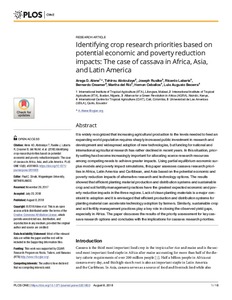| dc.contributor.author | Alene, A. |
| dc.contributor.author | Abdoulaye, Tahirou |
| dc.contributor.author | Rusike, J. |
| dc.contributor.author | Labarta, R. |
| dc.contributor.author | Creamer, Bernardo |
| dc.contributor.author | Rio, M. del |
| dc.contributor.author | Ceballos, H. |
| dc.contributor.author | Becerra, L.A. |
| dc.date.accessioned | 2019-12-04T11:24:20Z |
| dc.date.available | 2019-12-04T11:24:20Z |
| dc.date.issued | 2018-08-08 |
| dc.identifier.citation | Alene, A., Abdoulaye, T., Rusike, J., Labarta, R., Creamer, B., del Río, M., ... & Becerra, L.A. (2018). Identifying crop research priorities based on potential economic and poverty reduction impacts: the case of cassava in Africa, Asia, and Latin America. PloS ONE, 13(8):e0201803, 1-18. |
| dc.identifier.issn | 1932-6203 |
| dc.identifier.uri | https://hdl.handle.net/20.500.12478/4343 |
| dc.description | Open Access Journal |
| dc.description.abstract | It is widely recognized that increasing agricultural production to the levels needed to feed an expanding world population requires sharply increased public investment in research and development and widespread adoption of new technologies, but funding for national and international agricultural research has rather declined in recent years. In this situation, priority setting has become increasingly important for allocating scarce research resources among competing needs to achieve greater impacts. Using partial equilibrium economic surplus models and poverty impact simulations, this paper assesses cassava research priorities in Africa, Latin America and Caribbean, and Asia based on the potential economic and poverty reduction impacts of alternative research and technology options. The results showed that efficient planting material production and distribution systems and sustainable crop and soil fertility management practices have the greatest expected economic and poverty reduction impacts in the three regions. Lack of clean planting materials is a major constraint to adoption and it is envisaged that efficient production and distribution systems for planting material can accelerate technology adoption by farmers. Similarly, sustainable crop and soil fertility management practices play a key role in closing the observed yield gaps, especially in Africa. The paper discusses the results of the priority assessment for key cassava research options and concludes with the implications for cassava research priorities. |
| dc.format.extent | 1-18 |
| dc.language.iso | en |
| dc.subject | Cassava |
| dc.subject | Agricultural Production |
| dc.subject | Poverty |
| dc.subject | Technology |
| dc.title | Identifying crop research priorities based on potential economic and poverty reduction impacts: the case of cassava in Africa, Asia, and Latin America |
| dc.type | Journal Article |
| dc.description.version | Peer Review |
| cg.contributor.crp | Maize |
| cg.contributor.crp | Policies, Institutions and Markets |
| cg.contributor.crp | Roots, Tubers and Bananas |
| cg.contributor.affiliation | International Institute of Tropical Agriculture |
| cg.contributor.affiliation | Alliance for a Green Revolution in Africa |
| cg.contributor.affiliation | International Center for Tropical Agriculture |
| cg.contributor.affiliation | Universidad de Las Americas |
| cg.coverage.region | Africa |
| cg.coverage.region | Asia |
| cg.coverage.region | Latin America |
| cg.creator.identifier | Arega Alene: 0000-0002-2491-4603 |
| cg.creator.identifier | Tahirou Abdoulaye: 0000-0002-8072-1363 |
| cg.researchtheme | SOCIAL SCIENCE & AGRIBUSINESS |
| cg.isijournal | ISI Journal |
| cg.authorship.types | CGIAR and developing country institute |
| cg.iitasubject | Agribusiness |
| cg.iitasubject | Cassava |
| cg.iitasubject | Impact Assessment |
| cg.journal | PloS ONE |
| cg.howpublished | Formally Published |
| cg.accessibilitystatus | Open Access |
| local.dspaceid | 99947 |
| cg.targetaudience | Scientists |
| cg.identifier.doi | https://dx.doi.org/10.1371/ journal.pone.0201803 |

